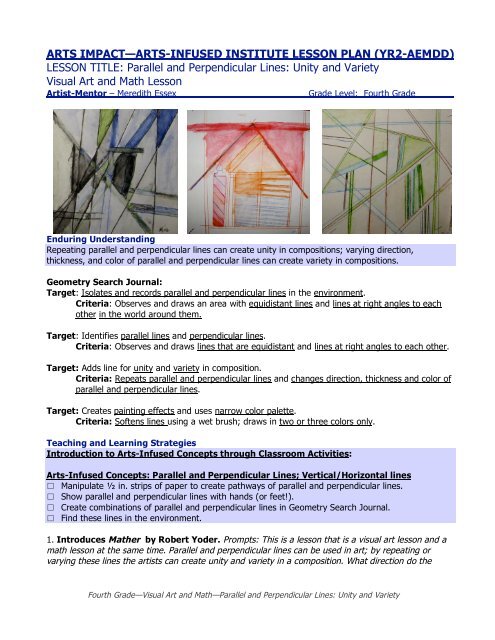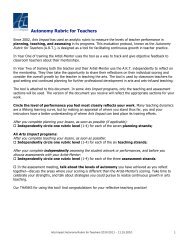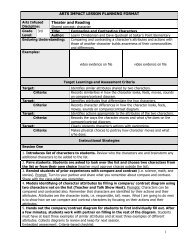Parallel and Perpendicular Lines - Arts Impact
Parallel and Perpendicular Lines - Arts Impact
Parallel and Perpendicular Lines - Arts Impact
Create successful ePaper yourself
Turn your PDF publications into a flip-book with our unique Google optimized e-Paper software.
ARTS IMPACT—ARTS-INFUSED INSTITUTE LESSON PLAN (YR2-AEMDD)LESSON TITLE: <strong>Parallel</strong> <strong>and</strong> <strong>Perpendicular</strong> <strong>Lines</strong>: Unity <strong>and</strong> VarietyVisual Art <strong>and</strong> Math LessonArtist-Mentor – Meredith EssexGrade Level: Fourth GradeEnduring Underst<strong>and</strong>ingRepeating parallel <strong>and</strong> perpendicular lines can create unity in compositions; varying direction,thickness, <strong>and</strong> color of parallel <strong>and</strong> perpendicular lines can create variety in compositions.Geometry Search Journal:Target: Isolates <strong>and</strong> records parallel <strong>and</strong> perpendicular lines in the environment.Criteria: Observes <strong>and</strong> draws an area with equidistant lines <strong>and</strong> lines at right angles to eachother in the world around them.Target: Identifies parallel lines <strong>and</strong> perpendicular lines.Criteria: Observes <strong>and</strong> draws lines that are equidistant <strong>and</strong> lines at right angles to each other.Target: Adds line for unity <strong>and</strong> variety in composition.Criteria: Repeats parallel <strong>and</strong> perpendicular lines <strong>and</strong> changes direction, thickness <strong>and</strong> color ofparallel <strong>and</strong> perpendicular lines.Target: Creates painting effects <strong>and</strong> uses narrow color palette.Criteria: Softens lines using a wet brush; draws in two or three colors only.Teaching <strong>and</strong> Learning StrategiesIntroduction to <strong>Arts</strong>-Infused Concepts through Classroom Activities:<strong>Arts</strong>-Infused Concepts: <strong>Parallel</strong> <strong>and</strong> <strong>Perpendicular</strong> <strong>Lines</strong>; Vertical/Horizontal linesManipulate ½ in. strips of paper to create pathways of parallel <strong>and</strong> perpendicular lines.Show parallel <strong>and</strong> perpendicular lines with h<strong>and</strong>s (or feet!).Create combinations of parallel <strong>and</strong> perpendicular lines in Geometry Search Journal.Find these lines in the environment.1. Introduces Mather by Robert Yoder. Prompts: This is a lesson that is a visual art lesson <strong>and</strong> amath lesson at the same time. <strong>Parallel</strong> <strong>and</strong> perpendicular lines can be used in art; by repeating orvarying these lines the artists can create unity <strong>and</strong> variety in a composition. What direction do theFourth Grade—Visual Art <strong>and</strong> Math—<strong>Parallel</strong> <strong>and</strong> <strong>Perpendicular</strong> <strong>Lines</strong>: Unity <strong>and</strong> Variety
lines you see in the art move? (vertical <strong>and</strong> horizontal) Trace them with your fingers. Find parallel <strong>and</strong>perpendicular lines in this painting composition. What effect does the difference of thickness of lineshave in this art (variety)? Imagine if all the lines were parallel <strong>and</strong> the same thickness?Student: Finds lines in art.2. Demonstrates using a viewfinder to isolate <strong>and</strong> draw three small areas in the room thathave parallel <strong>and</strong> perpendicular lines. Prompts: I am looking for an area where I see bothperpendicular <strong>and</strong> parallel lines—using the viewfinder is just like looking through a camera <strong>and</strong> figuringout what you want in your picture. Draw three rectangles on one page of your search journal: thenquickly sketch three different combinations of parallel <strong>and</strong> perpendicular lines that you see in the roomusing your viewfinder (in the rectangles). This is just a warm-up: do not worry about using rulers orerasing.Student: Observes <strong>and</strong> records parallel <strong>and</strong> perpendicular lines found in the environment.Embedded Assessment: Criteria-based teacher checklist3. Demonstrates making artistic decisions to develop composition. Prompts: I will use myruler/straightedge to draw my lines. I will only be using a total of 2 or 3 colors—a narrow palette (justlike the painting at which we looked).We are working with parallel <strong>and</strong> perpendicular lines so I amkeeping in mind that I want to repeat parallel <strong>and</strong> perpendicular lines, but also change the thickness<strong>and</strong> color of them. I am choosing two more colors of pencil for my narrow palette—I am thoughtfullyadding to my composition step by step.Student: Observes demonstration.4. Guides creative process. Prompts: Be thoughtful in your artistic choices. Think about how havinga variety of thickness <strong>and</strong> direction of parallel <strong>and</strong> perpendicular lines will make your compositionexciting. However, you will want to repeat lines to help unify your art too. Think about it step by step.Check in with a partner who can step back <strong>and</strong> hold your work up for you. Talk about what you willrepeat for unity <strong>and</strong> what you will add for variety.Student: Observes demonstration5. Demonstrates technique possibilities for using water soluble colored pencils. Prompts: Iam softening colored pencil lines using a barely wet brush—this art material is a combination ofdrawing <strong>and</strong> painting. I can add water to make a line a bit thicker or soften a color in my narrowpalette. Notice how Robert Yoder’s painting has variations of one color—light <strong>and</strong> dark. I can also dabaway water with a paper towel. It is very important that my lines are still clear in my composition, so Iam not brushing away my lines or changing them so they are no longer parallel or perpendicular—I canalso draw over the lines after adding water to re-define them.Student: Creates art.Embedded Assessment: Criteria-based peer critique; criteria-based self-assessment6. Facilitates criteria-based reflection. Displays art on the board. Prompts: Look at a classmate’sart <strong>and</strong> identify <strong>and</strong> sketch parallel <strong>and</strong> perpendicular lines you see in their art in your Geometry SearchJournal. Look closely at your own art—note <strong>and</strong> share what you added <strong>and</strong> repeated in yourcomposition for unity <strong>and</strong> what you added <strong>and</strong> changed for variety.Student: Participates is peer critique <strong>and</strong> self-reflection.Embedded Assessment: Criteria-based class critique; criteria-based peer <strong>and</strong> self assessmentFourth Grade—Visual Art <strong>and</strong> Math—<strong>Parallel</strong> <strong>and</strong> <strong>Perpendicular</strong> <strong>Lines</strong>: Unity <strong>and</strong> Variety
WritingClassroomWriting ActivityClassroomActivityARTCo- TeachARTModel/Co- TeachWritingClassroomActivityARTSupportedTeachWritingClassroomActivityWritingClassroomActivityIndependentPracticeWritingWASLBEFORE next VISUAL ART lesson:Math CentersMath1. Use graph/grid paper to create <strong>and</strong> label polygons with parallel <strong>and</strong> perpendicular sides.Math2. Observe <strong>and</strong> document parallel <strong>and</strong> perpendicular lines (in the environment, textiles,objects) in Geometry Search Journal.Math3. Ask students to lie down on the floor <strong>and</strong> create parallel <strong>and</strong> perpendicular lines.Remember parallel lines make a T.Independent Practice: H<strong>and</strong> draw! <strong>Parallel</strong> lines never cross—they stay the same distanceapart! <strong>Perpendicular</strong> lines cross or meet at right angles.Vocabulary Materials <strong>and</strong> Community Resource WA Essential Learnings & Frameworks<strong>Arts</strong>:color palettecompositionline directionnarrow palettethin/thick lineunityvarietyview finderwashwater-soluble coloredpencilsMuseum Artworks:Mather by Robert Yoder, 2002Art Materials:Geometry Search Journalviewfinders (slides with film removed to createwindow) or small tag board papers with windowopeningswater soluble colored pencilswatercolor paper: 9 x 9 in.rulersAEL 1.1 concepts: parallel <strong>and</strong> perpendicular lineAEL 1.1.2 principles of organization: unity <strong>and</strong>varietyAEL 1.2 skills <strong>and</strong> techniques: drawing, paintingAEL 2.1 applies creative process: gathersinformation, organizes, reflects, refinesAEL 4.2 connections between arts <strong>and</strong> other contentareas: geometry: parallel <strong>and</strong> perpendicular linesMath State FrameworksGrade 4: 1.3.1 Explains parallel <strong>and</strong> perpendicularlines <strong>and</strong> gives examples to demonstrate them<strong>Arts</strong> Infused:horizontalparallel linesperpendicular linesverticalwater containerspaper towelssmall nylon brushesFourth Grade—Visual Art <strong>and</strong> Math—<strong>Parallel</strong> <strong>and</strong> <strong>Perpendicular</strong> <strong>Lines</strong>: Unity <strong>and</strong> Variety
ARTS IMPACT—ARTS-INFUSED INSTITUTE LESSON PLAN (YR2-AEMDD)LESSON TITLE: <strong>Parallel</strong> <strong>and</strong> <strong>Perpendicular</strong> <strong>Lines</strong>: Unity <strong>and</strong> VarietyASSESSMENT WORKSHEETStudentsVISUAL ART AND MATH VISUAL ART VISUAL ARTPARALLEL LINESAND PERPENDICULAR LINESUNITY AND VARIETYTECHNIQUES: PencilNARROW PALETTEObserves <strong>and</strong> draws an area withequidistant lines <strong>and</strong> lines at rightangles to each otherin the world around themRepeatsparallel <strong>and</strong>perpendicularlinesSoftenslines drawn<strong>Parallel</strong><strong>Perpendicular</strong>Changesdirection,thickness <strong>and</strong>color of parallel<strong>and</strong>perpendicularlinesUsestwo orthreecolors ofpencilonly1.2.3.4.5.6.7.8.9.10.11.12.13.14.15.16.17.18.19.20.21.22.23.24.25.26.27.28.TotalPercentageCriteria-based Reflection Questions: (Note examples of student reflections.)Self-Reflection: Look closely at your own art—note what you repeated in composition forunity <strong>and</strong> what you changed for variety.Peer to Peer: Check in with a partner who can step back <strong>and</strong> hold your work up for you. Talkabout where you see parallel lines <strong>and</strong> perpendicular repeated for unity.Thoughts about Learning:Which prompts best communicated concepts? Which lesson dynamics helped or hindered learning?Total6Lesson Logistics:Which classroom management techniques supported learning?Teacher:Date:Fourth Grade—Visual Art <strong>and</strong> Math—<strong>Parallel</strong> <strong>and</strong> <strong>Perpendicular</strong> <strong>Lines</strong>: Unity <strong>and</strong> Variety
ARTS IMPACT—ARTS-INFUSED LEARNING FAMILY LETTERVISUAL ART AND MATH LESSON – <strong>Parallel</strong> <strong>and</strong> <strong>Perpendicular</strong> <strong>Lines</strong>: Unity <strong>and</strong> VarietyDear Family:Today your child participated in an visual art <strong>and</strong> math lesson.• We identified <strong>and</strong> sketched parallel <strong>and</strong> perpendicular lines seen in the art work, Mather, byRobert Yoder.• We isolated <strong>and</strong> recorded parallel <strong>and</strong> perpendicular lines that we saw in a small area of ourclassroom environment.• We repeated <strong>and</strong> changed direction, thickness <strong>and</strong> color of parallel <strong>and</strong> perpendicular linesto unify our compositions <strong>and</strong> add variety or visual interest to them.• We created painting effects: softened the lines using water-soluble colored pencils .<strong>and</strong>used a narrow color palette.• We looked at each other’s art <strong>and</strong> talked about how we effectively used parallel <strong>and</strong>perpendicular lines in our compositions.You could create compositions at home by making parallel <strong>and</strong> perpendicular lines with differentmaterials: sticks, ribbons, yarn. Weaving also uses parallel <strong>and</strong> perpendicular lines.Enduring Underst<strong>and</strong>ingRepeating parallel <strong>and</strong> perpendicular lines creates unity in compositions;varying direction, thickness, <strong>and</strong> color of parallel <strong>and</strong> perpendicular lines can create variety incompositions.Fourth Grade—Visual Art <strong>and</strong> Math—<strong>Parallel</strong> <strong>and</strong> <strong>Perpendicular</strong> <strong>Lines</strong>: Unity <strong>and</strong> Variety
















